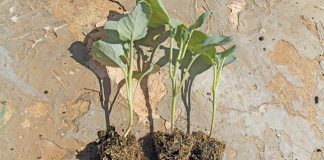I am sure that anyone who grows onions has experienced bolting at some time or another – if you haven’t you’re probably losing some of the crop’s potential. Bolting is the reproductive part of the onion life cycle and occurs after winter, going into warmer weather and longer days.
Onions naturally grow in summer, bulb and then wait a few months before growing out. When winter has passed they go into seed. However, we’ve messed around with their original natural cycles to suit our climatic conditions and to have onions all year round, as it is such an important vegetable.
It’s in your interest to understand the factors that influence bolting so you can maximise yield and avoid crop failures. You can use breeding selections to reduce bolting as much as possible. Under certain conditions all onions will bolt. Use your knowledge to maximise seed production.
The bottom line is that the greater the plant’s mass while it’s going through winter, the more it will bolt. In the short day areas where early planting is practised, you’ll have to plant early enough to get the bulbs to mature before winter, but not so early that they bulb in the seedling stages, as discussed in a previous article.
In winter in a cold area, the bulb development will slow down. The plants then wait until spring when the seed development or bolting will be initiated.
When planting in winter for summer bulbing, don’t plant too early, because if the plants have enough mass through the cold period they will bolt. In other words, you can plant much earlier in warm, short day areas such as the Mpumulanga Lowveld where there is far less cold to trigger the bolting.
For the same maturity season, growers in these areas can plant earlier and get much larger bulbs, thanks to both a longer growing period and warmer conditions. Planting is thus often done in late February/March in such climates, to let earlier maturing varieties mature in late September and later maturing ones in November.
The colder the area, the later you have to plant. For this same season, a March planting would guarantee bolters in a cold area, and April/May is thus a better time.
Say when
Plant as early as possible as a larger plant can produce a larger bulb. So how can you determine the best time to plant?
When starting out, be conservative for safety’s sake, but try smaller plantings earlier. Certain varieties are more susceptibile to bolting. If you hit the ideal planting date you’ll have only the odd bolter. This shows you that if you’d planted earlier, you’d have had a lot more and if you’d planted later, there would have been no bolters but a lower yield.
Also take into account that every year is slightly different, and make changes gradually to reduce risk. Planting in winter in cold areas poses other risks as the young seedlings may be damaged by severe frost. I once spoke to a grower from Texas, US, who told me that in his area it gets too cold to plant in winter, so he plants earlier and withholds nitrogen to keep the plants a certain size.
When spring approaches, he gives a good dressing of nitrogen once he knows from experience that the plants have past the bolting risk period. If he does this too soon, however, the plants will increase their mass and be vulnerable to bolting.
The bolting problem is practically eliminated for those who plant longer-day onions in the Western Cape. For their season, the plants are too small to bolt by the time winter is past and all development takes place in blissfully warm temperatures where the farmer can concentrate on providing ideal conditions for maximum yield.
Not for nothing is having a thorough knowledge of your subject called “knowing your onions”. But although this is a very complicated crop it’s very easy once you’ve developed the recipe for your situation. Its when you try and deviate from what you’re sure about that you make yourself vulnerable.
Contact Bill Kerr on 016 366 0616 or email [email protected].












